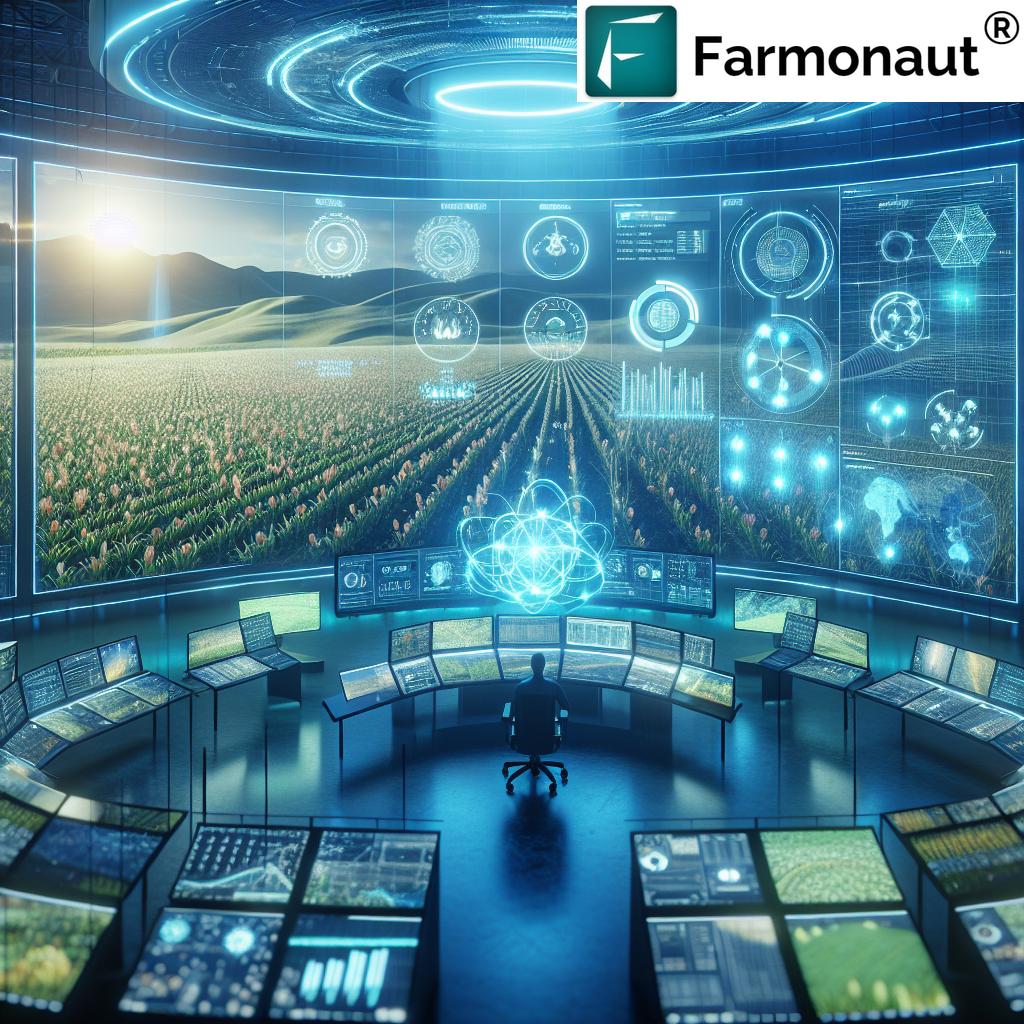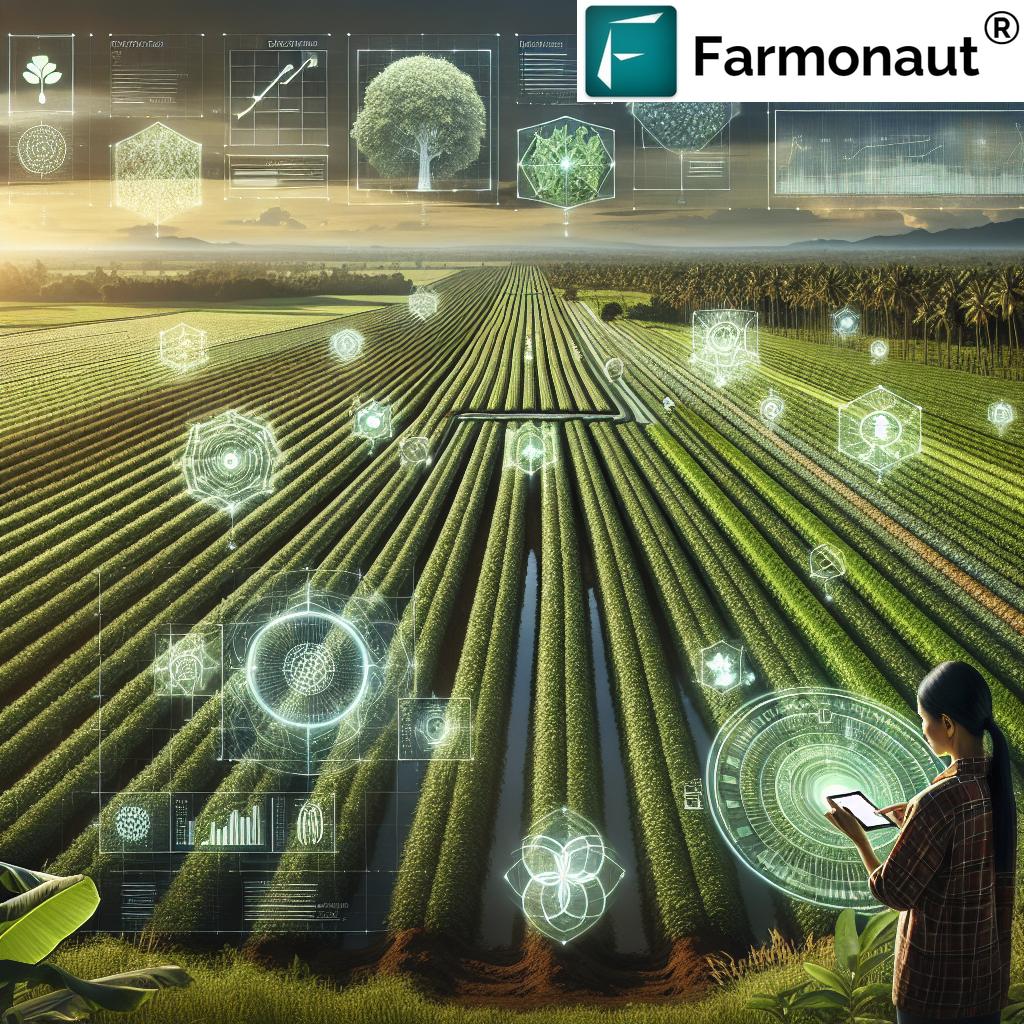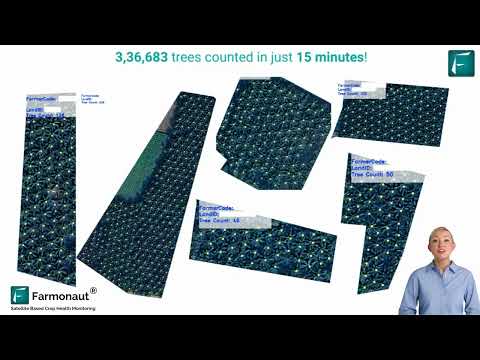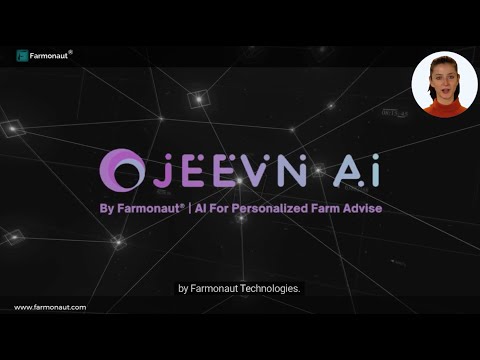Revolutionizing Agriculture: How AI and Farmonaut’s Smart Farming Solutions Transform Cooperative Extension Services

“AI-powered crop monitoring can increase agricultural productivity by up to 20% through precision farming techniques.”
In the ever-evolving landscape of agriculture, we are witnessing a remarkable transformation driven by artificial intelligence (AI) and smart farming solutions. As we delve into this technological revolution, we’ll explore how these advancements are reshaping cooperative extension services and precision farming technologies. At the forefront of this change is Farmonaut, a pioneering digital agriculture platform that’s leading the charge in sustainable agriculture practices.
The Dawn of AI in Agriculture
Artificial intelligence in agriculture is no longer a futuristic concept; it’s a present reality that’s revolutionizing the way we approach farming. From AI-powered crop monitoring to smart farming solutions, the integration of technology in agriculture is opening up new horizons for farmers, extension services, and agricultural data management.
Let’s explore how these innovations are transforming the agricultural landscape:
- Enhanced decision-making through real-time data analysis
- Precision farming techniques for optimal resource utilization
- Automated pest and disease detection
- Predictive analytics for crop yield estimation
As we navigate through this technological revolution, platforms like Farmonaut are at the forefront, offering cutting-edge solutions that make precision agriculture accessible to farmers worldwide.
Farmonaut: Pioneering Smart Farming Solutions
Farmonaut stands out as a leader in the agritech space, offering a comprehensive suite of tools that combine satellite technology, AI, and blockchain to meet the diverse needs of modern agriculture. Let’s take a closer look at how Farmonaut is transforming cooperative extension services and precision farming:
- Satellite-Based Crop Health Monitoring: Farmonaut utilizes multispectral satellite images to provide farmers with real-time insights into vegetation health, soil moisture levels, and other critical metrics.
- Jeevn AI Advisory System: This AI-driven tool delivers personalized farm advice, weather forecasts, and expert crop management strategies to farmers.
- Blockchain-Based Product Traceability: Ensuring transparency and security in agricultural supply chains.
- Fleet and Resource Management: Optimizing vehicle usage and improving overall management of agricultural machinery.
- Carbon Footprinting: Helping agribusinesses monitor and reduce their environmental impact.
By offering these advanced solutions, Farmonaut is democratizing access to precision agriculture and making it more affordable for farmers of all scales.
Transforming Cooperative Extension Services
Cooperative extension services have long been a cornerstone of agricultural education and support. With the integration of AI and smart farming solutions, these services are undergoing a significant transformation. Here’s how:
- Enhanced Information Delivery: AI-powered systems can provide real-time, data-driven advice to farmers.
- Personalized Learning: Machine learning algorithms can tailor information to individual farmer needs.
- Improved Resource Allocation: AI helps extension services optimize their resources for maximum impact.
- Data-Driven Decision Making: Advanced analytics enable more informed policy and program decisions.
These advancements are not just theoretical; they’re being put into practice through innovative projects like the Engagement Hub, which fosters lifelong learning and workforce development in agriculture.
Overcoming Challenges in Extension Services
While the potential of AI in agriculture is immense, extension services face several challenges in implementing these technologies:
- Digital Literacy: Ensuring farmers and extension agents are comfortable with new technologies.
- Data Privacy and Security: Protecting sensitive agricultural data in digital systems.
- Infrastructure Limitations: Overcoming connectivity issues in rural areas.
- Integration with Existing Systems: Seamlessly incorporating AI tools into current extension practices.
To address these challenges, we’re seeing innovative solutions emerge:
- AI-Driven Chatbots and Virtual Assistants: Providing 24/7 support to farmers and extension agents.
- Mobile-First Solutions: Developing applications that work well on smartphones, which are widely used even in rural areas.
- Offline Capabilities: Creating tools that can function without constant internet connectivity.
- Collaborative Platforms: Fostering knowledge sharing between farmers, researchers, and extension agents.
“Farmonaut’s digital agriculture platform has helped over 10,000 farmers adopt sustainable farming practices in the last year.”
The Power of Machine Learning in Agricultural Data Management
Machine learning is revolutionizing how we handle and interpret agricultural data. Here’s how it’s making a difference:
- Creating Structured Data: ML algorithms can convert unstructured extension content into organized, searchable databases.
- Predictive Analytics: Forecasting crop yields, pest outbreaks, and market trends with increasing accuracy.
- Image Recognition: Identifying plant diseases, pests, and crop health issues from photos.
- Natural Language Processing: Enabling more natural interactions between farmers and AI-powered advisory systems.
These advancements are crucial in developing effective AI applications for agriculture. They’re helping create more robust, user-friendly tools that can significantly enhance farm productivity and sustainability.
Explore Farmonaut’s API for advanced agricultural data solutions
The Importance of Agricultural Ontologies
As we delve deeper into AI applications in agriculture, the development of comprehensive agricultural ontologies becomes increasingly important. But what exactly are ontologies, and why do they matter?
Ontologies in agriculture are structured vocabularies that define the relationships between various concepts in the field. They serve as a common language for both humans and machines, enabling more effective communication and data integration. Here’s why they’re crucial:
- Standardization: Ontologies provide a standardized way of describing agricultural concepts, reducing ambiguity and improving data interoperability.
- Knowledge Representation: They help in organizing and representing complex agricultural knowledge in a machine-readable format.
- Enhanced Search and Retrieval: With well-defined ontologies, searching for specific agricultural information becomes more precise and efficient.
- Facilitating AI and Machine Learning: Ontologies provide the structured data necessary for training more accurate and context-aware AI models.
By developing comprehensive ontologies, we’re laying the groundwork for more sophisticated AI applications in agriculture, from automated crop management systems to intelligent decision support tools for farmers and extension agents.
Open Data and Emerging Technologies in Agriculture
The concept of open data is gaining traction in the agricultural sector, presenting new opportunities for innovation and collaboration. Here’s how open data and emerging technologies are enhancing outreach and service delivery in agriculture:
- Collaborative Research: Open data facilitates knowledge sharing between universities, research institutions, and farmers.
- Transparent Decision-Making: Access to open agricultural data enables more informed policy decisions and resource allocation.
- Innovation Catalyst: Startups and developers can leverage open data to create new tools and applications for farmers.
- Improved Forecasting: Combining open weather data with AI can lead to more accurate crop yield predictions and climate adaptation strategies.
Emerging technologies like blockchain, Internet of Things (IoT), and edge computing are also playing crucial roles in transforming agriculture:
- Blockchain: Enhancing traceability in supply chains and ensuring fair pricing for farmers.
- IoT Sensors: Providing real-time data on soil conditions, crop health, and weather patterns.
- Edge Computing: Enabling faster data processing and decision-making, even in areas with limited connectivity.
These technologies, when combined with AI and open data initiatives, are creating a more connected, efficient, and sustainable agricultural ecosystem.
Access Farmonaut’s API Developer Docs for in-depth technical information
The Roadmap for AI Integration in Extension Systems
Integrating AI into extension systems is a complex process that requires careful planning and execution. Here’s a roadmap for successful AI integration:
- Assessment and Planning:
- Evaluate current extension systems and identify areas for AI enhancement
- Set clear goals and metrics for AI implementation
- Develop a phased approach for gradual integration
- Infrastructure Development:
- Invest in necessary hardware and software infrastructure
- Ensure robust data collection and management systems
- Establish secure and scalable cloud computing resources
- Capacity Building:
- Train extension agents and farmers on AI tools and applications
- Develop AI literacy programs for agricultural communities
- Foster a culture of continuous learning and adaptation
- Pilot Projects and Scaling:
- Implement small-scale AI projects to test effectiveness
- Gather feedback and iterate on solutions
- Gradually scale successful projects to broader implementation
- Collaboration and Partnerships:
- Engage with tech companies, universities, and research institutions
- Participate in knowledge-sharing networks and communities of practice
- Collaborate on open-source AI projects for agriculture
This roadmap provides a structured approach to integrating AI into extension systems, ensuring that the transition is smooth, effective, and beneficial for all stakeholders.

Comparative Analysis: Traditional vs. AI-Powered Cooperative Extension Services
| Aspect | Traditional Extension Services | AI-Powered Extension Services (e.g., Farmonaut) |
|---|---|---|
| Data Collection Methods | Manual surveys, field visits | Satellite imagery, IoT sensors, AI-driven data aggregation |
| Information Delivery Speed | Days to weeks | Real-time to hours |
| Precision in Crop Monitoring | Limited, based on periodic observations | High precision, continuous monitoring |
| Scalability | Limited by human resources | Highly scalable, can cover vast areas |
| Personalization | Generic advice based on regional trends | Tailored recommendations for individual farms |
| Cost-Effectiveness | High operational costs for field visits | More cost-effective due to automation and remote sensing |
The Future of AI in Agriculture and Extension Services
As we look to the future, the potential of AI in agriculture and extension services is boundless. Here are some exciting developments on the horizon:
- Advanced Predictive Models: AI systems that can forecast crop yields, pest outbreaks, and market trends with even greater accuracy.
- Autonomous Farming Systems: Self-driving tractors and drones that can perform tasks with minimal human intervention.
- Personalized Crop Varieties: AI-assisted breeding programs that develop crop varieties tailored to specific microclimates and farming practices.
- Virtual Reality Training: Immersive VR experiences for training farmers and extension agents on new techniques and technologies.
- AI-Powered Policy Making: Data-driven decision support systems for agricultural policy formulation and implementation.
These advancements promise to make agriculture more efficient, sustainable, and resilient in the face of global challenges like climate change and food security.
The Critical Role of Collaboration
Building impactful, community-focused agricultural solutions requires a collaborative approach. Here’s why collaboration is crucial:
- Knowledge Sharing: Collaboration allows for the exchange of ideas and best practices across different regions and disciplines.
- Resource Optimization: By working together, organizations can avoid duplication of efforts and make better use of limited resources.
- Innovation Acceleration: Collaborative projects often lead to breakthrough innovations by combining diverse expertise and perspectives.
- Wider Impact: Partnerships between tech companies, research institutions, and extension services can reach a broader audience of farmers.
Platforms like Farmonaut play a vital role in fostering this collaboration by providing tools and data that can be leveraged by various stakeholders in the agricultural ecosystem.
Conclusion: Embracing the AI Revolution in Agriculture
As we’ve explored throughout this blog post, the integration of AI and smart farming solutions is revolutionizing agriculture and transforming cooperative extension services. From AI-powered crop monitoring to blockchain-based traceability, these technologies are making precision agriculture more accessible and sustainable.
Platforms like Farmonaut are at the forefront of this revolution, offering innovative solutions that empower farmers, improve productivity, and promote sustainable agricultural practices. As we move forward, the continued development of AI technologies, coupled with collaborative efforts and open data initiatives, will be crucial in addressing global agricultural challenges and ensuring food security for future generations.
The future of agriculture is smart, sustainable, and data-driven. By embracing these technological advancements and fostering collaboration between all stakeholders, we can create a more resilient and productive agricultural sector that benefits farmers, consumers, and the planet alike.
FAQs
- What is AI in agriculture?
AI in agriculture refers to the use of artificial intelligence technologies such as machine learning, computer vision, and predictive analytics to improve various aspects of farming, including crop monitoring, yield prediction, and resource management. - How does Farmonaut use AI in its solutions?
Farmonaut leverages AI through its Jeevn AI Advisory System, which analyzes satellite data and other inputs to provide personalized farm advice, weather forecasts, and crop management strategies. - What are the benefits of AI-powered extension services?
AI-powered extension services offer real-time data analysis, personalized recommendations, improved resource allocation, and the ability to reach a larger number of farmers more efficiently. - How can farmers access Farmonaut’s services?
Farmers can access Farmonaut’s services through their web application, Android app, or iOS app. The platform offers various subscription packages tailored to different needs and farm sizes. - What is the role of blockchain in Farmonaut’s solutions?
Farmonaut uses blockchain technology to provide traceability solutions, ensuring transparency and security in agricultural supply chains from farm to consumer.






